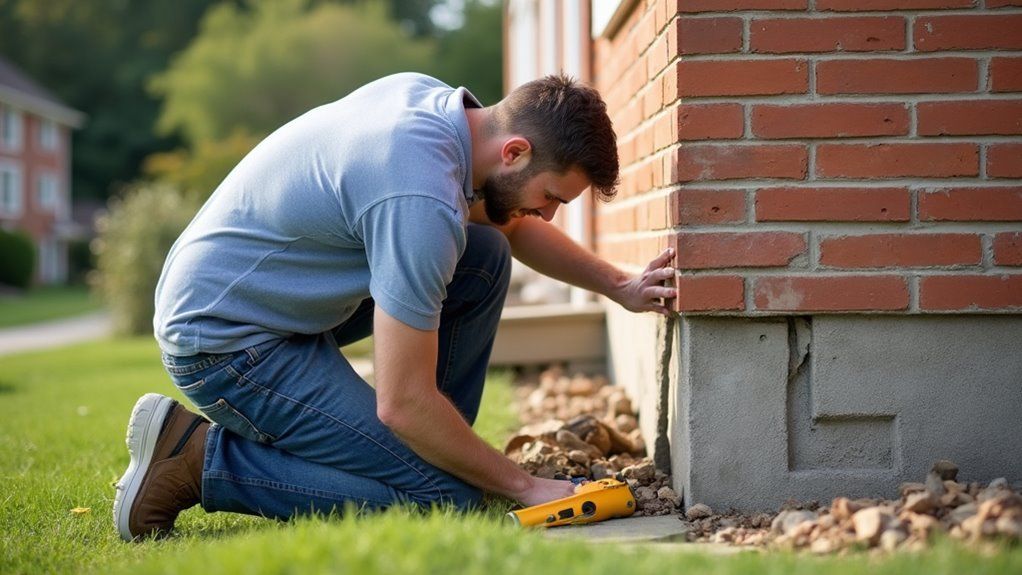How to Identify Foundation Issues Before Selling

If you want to sell your home, foundation issues can be a big problem. Even small cracks or uneven floors can scare buyers away. These problems might lower your home’s value or delay your sale.
Buyers notice even the smallest flaws, and they may ask for expensive repairs or a lower price. Ignoring these warning signs can turn a simple sale into a stressful process.
You could lose money if you wait too long to fix the issues. You can spot foundation problems early by knowing what signs to look for before selling.
This guide will show you how to check your home and what steps to take next. With the right knowledge, you can protect your home’s value and sell with confidence.
This blog will help you find and fix foundation issues before they hurt your sale.
Key Takeaways
- Look for cracks in interior walls, ceilings, and around windows or doors, especially those wider than 1/8 inch or growing over time.
- Check for uneven or sloping floors, gaps near baseboards, or sticking doors and windows that indicate possible foundation movement.
- Inspect basement and crawl spaces for wall cracks, dampness, water leaks, musty odors, or rusted support columns as signs of foundation problems.
- Ensure gutters are unclogged, downspouts direct water away from the foundation, and yard grading slopes away from the house to prevent water damage.
- Consult a structural engineer or foundation specialist if you notice large cracks, uneven floors, or other significant warning signs.
Understanding the Importance of a Solid Foundation
A solid foundation is essential for your home's safety and value. It supports the house and keeps it stable over time. If the foundation is weak, the whole structure is at risk.
Proper documentation and clear ownership of the property can also streamline the sale process and prevent legal complications. Foundation problems often cause cracks or uneven floors. Doors may not close properly if the soil shifts. These issues can lower your home's value.
Homeowners should look for signs of foundation damage before selling. If you find problems, fixing them can make your home more appealing. Buyers feel more confident when the foundation is strong. If you do not repair foundation issues, you could face expensive repairs later.
Addressing problems early protects your investment. Understanding foundation issues and their impact can help you decide whether repairs are worthwhile before listing your home. A solid foundation helps you achieve a successful sale.
Common Causes of Foundation Problems
Foundation problems often happen because of changes in the soil under your home. Soil movement or moisture changes can damage the foundation. These issues need quick attention to prevent bigger problems. Recognizing signs early can help you prevent costly repairs and maintain your property's value. Poor drainage is a common cause of foundation trouble.
Water from clogged gutters or bad grading can collect near the foundation. This extra water makes soil expand or wash away. Some soils, such as clay, can swell when wet and shrink when dry. This movement puts stress on the foundation.
Homes built on unstable soil are more likely to have foundation issues. Large tree roots can also cause problems if they grow close to the house. Roots can pull moisture from the soil or shift the ground. If this happens, cracks or settling may start to appear.
Additionally, soil instability caused by poor grading or construction can further exacerbate foundation problems. If you know these causes, you can fix problems early. Early action can prevent costly repairs later. Regular checks help protect your home's foundation.
Signs of Foundation Trouble Inside Your Home
Start by checking for cracks in your interior walls, especially around windows and door frames, as these often indicate shifting or settling.
Notice if your doors are sticking or no longer close properly—uneven or misaligned doors signal possible foundation movement. Addressing these warning signs promptly helps you prevent further structural complications before listing your home.
Additionally, paying attention to foundation issues can help you identify problems early and potentially avoid costly repairs or delays in your sale process. Recognizing timely inspections can further aid in assessing the severity of foundation concerns before selling.
Cracks in Interior Walls
Hairline cracks in your living room walls can be harmless or signs of foundation problems. If a crack is small and does not change, it is usually normal. Larger or growing cracks may need attention.
Horizontal or jagged cracks near doors or windows often show foundation movement. Cracks wider than 1/8 inch can mean the soil under your house is shifting. If a crack gets bigger over time, you should take it seriously.
Multiple cracks in different rooms may show a bigger problem. Cracks along the same wall can also mean your house is shifting. If you see these signs, it is best to call a professional.
If you act early, you can protect your home’s value. Checking cracks as soon as you notice them is a good idea. Early repairs are often easier and less costly.
Uneven or Sticking Doors
Uneven or sticking doors often mean there is a problem with your home’s foundation. If a door will not close or drags, the foundation may have shifted. Sometimes, soil erosion or settling under your house can cause this movement.
If you see gaps around the door or it will not latch, the frame may be misaligned. These changes often happen when the foundation moves or settles unevenly. A door that suddenly sticks could signal soil erosion beneath your house.
You should not ignore these signs. If you plan to sell your home, get a professional inspection first. Early repairs can protect your property’s value and help you avoid expensive problems later.
Cracks in Walls and Ceilings: What They Mean
You’ll need to assess crack patterns in your walls and ceilings, their shape and direction often signal different structural concerns. Pay close attention to the severity and location—wide, jagged, or stair-step cracks near doors and windows usually indicate foundation movement. Document these issues early so you can address potential repairs before listing your property.
Additionally, consulting a professional can help determine whether the cracks are a sign of serious foundation problems or minor settling. Recognizing foundation movement early can save you from costly repairs down the line. Proper pricing strategy is essential to attract buyers who may be wary of structural issues, and addressing these concerns upfront can facilitate a quicker sale.
Types of Crack Patterns
Crack patterns can help you understand possible problems in your home’s foundation. If you know what to look for, you can spot issues early. This knowledge is useful before selling your home.
Horizontal cracks usually appear in basement walls. These cracks may mean there is too much pressure from the soil outside. If you see them, you might need soil stabilization soon.
Stair-step cracks are often found in brick or block walls. They can show that your foundation is settling unevenly. You may need to reinforce the foundation if these cracks appear.
Vertical cracks may be caused by normal settling. However, if they are wide or getting bigger, there could be a structural problem. If this happens, a professional should check them.
If you spot any of these cracks, consider repairs as soon as possible. Early action can help you avoid expensive problems later. It also helps you prepare your home for sale.
Severity and Location
Crack severity and location help identify the cause and urgency of wall and ceiling damage. Wide or long cracks often mean serious problems. Small cracks near doors or windows are usually less urgent.
Cracks near wall and ceiling joints may show soil or foundation issues. If you see cracks wider than a quarter-inch, seek help. Cracks that spread quickly need immediate attention.
Cracks parallel to framing are often less serious. If cracks cut across structural elements, they could mean bigger risks. Always record crack details to share with a professional.
Uneven or Sloping Floors
Uneven or sloping floors often mean there is a problem with your home's foundation. These floors may tilt or show gaps near baseboards. If you notice these issues, your foundation may need attention.
You can check for floor problems using simple tools. Place a marble or a level on different areas to find slopes. Look for gaps at joints, especially near walls or doors. foundation issues can sometimes cause structural problems that worsen over time if not addressed promptly.
Check your flooring for damage. Cracked tiles, warped wood, or lifted laminate may point to foundation stress. Fixing these problems early can help you avoid expensive repairs later. Being aware of signs like uneven floors can help you identify potential foundation problems before they become severe.
Sticking Doors and Windows
When you notice doors or windows sticking or failing to latch, treat these as warning signs of possible foundation movement. Shifting or settling can distort frames, indicating compromised structural integrity.
Inspect each problem area carefully and consult a qualified contractor to address underlying causes before listing your home.
Additionally, understanding necessary documents for selling an inherited property can streamline the process if you decide to sell. Recognizing signs of foundation issues early can prevent costly repairs and help ensure a smoother sale process, especially when dealing with liens on a property.
Common Problem Signs
Sticking doors and windows are often early signs of foundation problems. If you catch these issues early, you can avoid expensive repairs. These warning signs mean there could be trouble with your home's foundation.
Persistent jamming of doors or windows often shows foundation movement. Visible gaps between frames and walls suggest the soil is shifting. Uneven or tilted frames can also mean the foundation is moving.
If you notice any of these signs, inspect your home’s foundation. Early action can help keep your home safe and maintain its value. Ignoring these problems could lead to bigger and more costly repairs.
Potential Structural Causes
Sticking doors and windows often mean there are problems with your home's foundation. These issues usually happen when the ground under your house changes. If the soil shifts, it can make the foundation uneven and cause misalignment.
Soil movement can result from moisture changes, poor soil compaction, or erosion. Concrete foundations may settle or sink into weak soil layers. This puts extra pressure on doors and windows, making them hard to use.
If you notice these signs, your foundation might be damaged. You should address these issues before selling your home. Ignoring them could lead to bigger and more expensive repairs later.
Inspection and Solutions
Soil movement and foundation shifts can make doors and windows stick. You can check these issues by inspecting your home's entry points. If you notice problems, simple checks can help you find the cause.
Start by opening and closing each door and window. Note if you feel resistance or see gaps. These signs may point to structural changes.
Look at the frames and sills for cracks or spaces between the wall and frame. Cracks or gaps suggest movement in the foundation. If you see these, your foundation may need attention.
Use a level tool on window sills and door thresholds. Any tilt or unevenness can show a shift in the foundation. If the level is off, there may be an underlying issue.
If you find any of these problems, contact a structural engineer. An expert can recommend the right solution. Quick action can prevent bigger repairs later.
Inspecting Your Basement or Crawl Space
Basements and crawl spaces are key areas to check for foundation problems. These spaces can show early signs of structural damage. Homeowners should inspect them regularly. Look for cracks in the walls and signs of water leaks.
Damp smells, mold, or white stains may mean moisture is present. If you see any of these, repairs may be needed. Check that basement waterproofing systems are working well. Blocked crawl space vents can trap moisture and cause wood to rot.
Damaged vents should be fixed right away. Support columns must be straight and free from rust. Floor joists should be level and show no signs of insect damage. If you notice issues, address them early to avoid expensive repairs before selling your home.
Regularly inspecting these areas can also help identify foundation issues early, potentially saving you from costly repairs later. Additionally, understanding selling 'As Is' considerations can help you navigate repairs or disclosures efficiently when preparing your property for sale.
Exterior Warning Signs to Watch For
You should check the outside of your home for signs of foundation problems. Walk around the house and look for any warning signs. Exterior issues can point to bigger problems underneath.
Cracks in the brickwork or foundation walls may mean the ground is moving. Horizontal, stair-step, or wide vertical cracks are reasons to worry. These cracks should be checked by a professional if you find them.
Uneven landscaping or soil erosion can cause water to flow toward your foundation. Poor grading increases the risk of damage. If you see this, consider fixing the slope of the soil.
Damaged or peeling paint near the bottom of walls may show there is moisture getting inside. This can happen if the foundation shifts. If paint keeps peeling, have an expert check for water issues.
If you spot these warning signs early, repairs may be easier and less expensive. Early attention can also help keep your home’s value. Taking care of these problems can make selling your home simpler later.
Being aware of foundation movement and addressing issues promptly can prevent minor problems from escalating into major structural repairs.
Gaps Around Windows and Doors
Gaps around windows and doors often mean your foundation has moved. Foundation shifts can push or pull on frames, causing visible gaps. These gaps may let in drafts, moisture, and even pests.
If you see gaps, close each window or door to check for uneven spaces or hard latching. A flashlight can help you spot light coming through cracks. You should measure each gap with a ruler and write down the size.
If gaps get bigger or new ones appear, contact a structural engineer. Early help can stop small problems from becoming expensive repairs. This can also protect your home’s value if you want to sell.
Checking for Water Damage and Drainage Issues
You need to watch for basement moisture, as stains or musty odors often signal underlying foundation concerns. Check that your gutters channel water away efficiently, preventing overflow and soil erosion near the house. Assess your yard’s grading to ensure water flows away from the foundation, not toward it.
Spotting Basement Moisture Signs
Basement moisture can be an early sign of foundation trouble. You should check carefully for water damage and drainage problems. If you find moisture, address it before selling your home.
Efflorescence is a white, chalky substance on basement walls. This means water is moving through the concrete and leaving minerals behind. Efflorescence often points to water leaks.
Damp spots or stains show water is getting into the basement. These marks on floors or walls suggest drainage issues. If you see them, your basement may need repairs.
A musty smell in the basement often means mold or mildew is present. This odor usually comes from too much humidity or poor air flow. Fixing these issues can protect your home’s value.
If you notice any of these signs, take action quickly. Prompt repairs can prevent bigger problems later. Buyers will feel more confident in a well-maintained home.
Evaluating Gutter Effectiveness
Gutters are meant to carry rainwater away from your home’s foundation. If they work well, water will not collect near the house. This helps prevent costly damage to your foundation.
Check your gutters for clogs, sagging, or leaks. Blocked or damaged gutters can cause water to spill over and pool near your home. If you see these problems, maintenance is needed.
Ensure that downspouts direct water at least five feet from the foundation. If water collects near your house after rain, install downspout extenders or splash blocks. This keeps water away from the base of your home.
Look for water stains or ground erosion under your gutters. These signs show poor drainage and must be fixed quickly. Addressing gutter issues early protects your home’s structure.
Inspecting Yard Grading
Yard grading affects how water moves around your home. A yard should slope away from the house to stop water from pooling. If the slope is wrong, water may reach your foundation.
Improper grading can cause drainage problems and foundation damage. Compacted soil keeps water from flowing away from your home. Tree roots near the house can also change drainage and crack the foundation.
If you see water collecting near your house, check the yard's slope. The ground should drop six inches within ten feet of the foundation. Fix grading issues quickly to protect your property.
Evaluating the Condition of Your Chimney
A chimney's condition can show early signs of foundation problems. Check the chimney carefully for damage before problems get worse. This helps you spot issues early.
Look for visible cracks or gaps between the chimney and the house. If the chimney is tilting, it may signal foundation movement. Crumbling mortar joints can also mean the foundation is shifting.
Inspect the flue for damage or misalignment. If the flue is damaged, the chimney may have moved. Gaps inside where the chimney meets walls or ceilings are another warning sign.
If you see the chimney leaning, address the problem right away. An unstable chimney can be dangerous and point to bigger issues. Always write down what you find to plan repairs before selling your home.
When to Call a Foundation Specialist
Call a foundation specialist if you see problems you cannot fix yourself. Some warning signs mean your home may have serious issues. These problems often need expert help right away.
Large cracks in walls or the foundation are a big concern. Uneven floors or doors that do not close can mean shifting under your home. Water in the basement or crawl space may show foundation or soil problems.
A specialist can find the cause and suggest solutions. Quick action can protect your home’s value. If you plan to sell, this also helps reassure buyers.
Repair Options and What to Expect
Foundation repair has several options depending on the problem. Common repairs target different types of damage and foundation types. If you have cracks or shifting, a professional can recommend the best method.
Epoxy injections work well for small cracks in concrete slabs. Steel piers are often used when there is major settling in unstable soil. Helical piers may be best if your house is lightweight and the soil is weak.
Slabjacking can raise sunken concrete slabs quickly. Wall anchors help fix bowing or leaning basement walls. If you are unsure which repair fits your issue, ask a professional to match the repair to your home’s needs.
Preparing for the Home Inspection Process
Getting ready for a home inspection is important after fixing your foundation. The inspector will check if your repairs follow local rules and are strong. You should prepare well to answer any questions about the work.
Homeowners should collect all paperwork related to the repairs. This includes receipts, soil test reports, and any warranties. These documents help prove the repairs were done right.
Areas like crawl spaces, basements, and outside walls must be easy to reach. Clear away any clutter or obstacles before the inspection. This allows the inspector to check everything closely.
It is useful to look at old inspection reports if you have them. Compare them with the current condition of your home. This will help you explain what has been improved or fixed.
Conclusion
If you identify foundation issues early, you can prevent unexpected problems during the sale process. Taking steps to check for warning signs, like uneven floors or wall cracks, helps you stay prepared. If you act quickly, you can save time and money in the long run.
When you address foundation concerns before listing, you protect your home’s value and make negotiations easier. If you need to sell fast, selling your house for cash is also an option. If you prefer a quick and simple sale, you can avoid repair delays and inspection worries.
If you want to sell your house as-is, we at Tulsa Home Buyers can help. If you contact us today, we can give you a fair cash offer. If you’re ready for a hassle-free sale, let us take care of the process for you.
This is paragraph text. Click it or hit the Manage Text button to change the font, color, size, format, and more. To set up site-wide paragrapTulsa Home Buyers • August 24, 2025h and title styles, go to Site Theme.
Ready to work with Tulsa Home Buyers?
Let's connect! We’re here to help.
Send us a message and we’ll be in touch.
Or give us a call today at 111-222-3333


